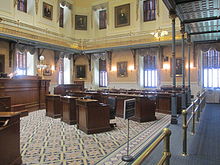
Back مجلس شيوخ كارولاينا الجنوبية Arabic Senat von South Carolina German Sénat de Caroline du Sud French הסנאט של קרוליינה הדרומית HE Senato della Carolina del Sud Italian サウスカロライナ州議会元老院 Japanese South Carolinas senat Swedish South Carolina Chham-gī-īⁿ ZH-MIN-NAN
South Carolina State Senate | |
|---|---|
| South Carolina General Assembly | |
 Seal of the South Carolina Senate | |
| Type | |
| Type | |
Term limits | None |
| History | |
New session started | January 9, 2024 |
| Leadership | |
Majority Leader | |
Minority Leader | |
| Structure | |
| Seats | 46 |
 | |
Political groups | Majority
Minority
|
Length of term | 4 years |
| Authority | Article III, South Carolina Constitution |
| Salary | $10,400/year + per diem |
| Elections | |
Last election | November 5, 2024 (46 seats) |
Next election | 2028 South Carolina Senate election |
| Redistricting | Legislative Control |
| Meeting place | |
 | |
| State Senate Chamber South Carolina State House Columbia, South Carolina | |
| Website | |
| South Carolina Senate | |
| Rules | |
| Rules of the Senate of South Carolina | |

The South Carolina Senate is the upper house of the South Carolina General Assembly, the lower house being the South Carolina House of Representatives. It consists of 46 senators elected from single member districts for four-year terms at the same time as United States presidential elections.
The South Carolina Constitution of 1895 provided for each county to elect one senator for a four-year term. The election of senators was staggered so that half of the state Senate was elected every two years. After the U.S. Supreme Court ruled in 1964 for the case Reynolds v. Sims, the state Senate was reapportioned in 1966 as a temporary measure into 27 districts with 50 members for two-year terms. In 1967, the state Senate was again reapportioned, this time into 20 districts with 46 members for four-year terms. The number of districts was reduced to 16 in 1972 and in 1984, they were eliminated with the creation of single member districts.
The annual session of the General Assembly convenes at the State Capitol Building in Columbia on the second Tuesday of January of each year. However, after convening, either the House or the Senate may call for itself a 30-day recess by a majority vote, or a longer recess by a two-thirds vote.[1]
- ^ "ARTICLE 3. Legislative Department., SECTION 9. Sessions of General Assembly". 2010 South Carolina Constitution – Unannotated. Archived from the original on March 4, 2012. Retrieved January 16, 2012.